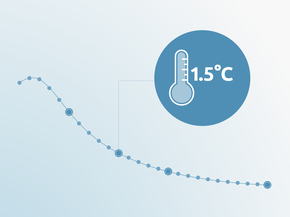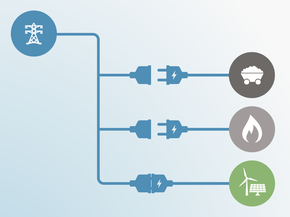Current Policy Projections
Economy-wide
Neither implemented nor planned policies are sufficient to achieve the Philippines’ NDC target. Emissions growth will be predominantly driven by increased emissions from transport and coal-fired electricity generation. Current policy projections indicate a rapid and ongoing increase in greenhouse gas emissions, which appear inconsistent with meeting the NDC commitments.
Emissions under current policies (excluding LULUCF) are expected to increase up to about 209 MtCO2e/yr in 2020 and 296 MtCO2e/yr in 2030 (see “Current policy projections” in the graph). However, if the current upswing of development in coal power plants were to continue, this would represent a significant emissions contribution that would strongly limit the country’s capacity to achieve its target.
If the Philippines fully implements policies and proposed targets, most notably the tripling in renewable power capacity by 2030, compared to 2010, and achieves the 10% energy efficiency target, total GHG emissions in 2030 could decrease to approximately 265 MtCO2e/yr (see “Planned policy projections” in the graph). This would be a reduction of 8% in 2030 compared to our current policy projections.
The National Climate Change Action Plan (NCCAP) offers a framework to implement mitigation and adaptation strategies and involves institutional changes and capacity building to facilitate climate change policies. However, the NCCAP in itself does not enforce quantifiable measures, so the targets from the NCCAP are not included in current policy projections.
The Department of Energy approved the Energy Efficiency Roadmap in December 2014 (covering the period 2014–2030) and its corresponding short-term Energy Efficiency Action Plan in December 2015 (for the planning period 2016-2020), both of which have been prepared with the support of the European Union (Department of Energy, 2016a). Overall, the Energy Efficiency Roadmap mandates energy savings equivalent to 10% across energy demand sectors in 2030, compared to the reference energy demand outlook. Both policy documents list various measures to enhance energy efficiency in the buildings, industry, energy supply, and transport sectors. The Energy Efficiency Action Plan is being implemented by the Energy Efficiency and Conservation Division of the Energy Utilization Management Bureau of the Department of Energy, but the extent and coverage of implementation is unclear.
Energy supply
In 2015, the Department of Energy (DoE) announced that more than 10 GW of coal-fired power plant capacity would be constructed in the Philippines by 2025, and released a Coal Roadmap 2017–2040 (Department of Energy, 2017a). If all these power plants were built, it would be difficult for the government to achieve its NDC target (excluding LULUCF), especially because the recent upswing of development in the coal industry has encouraged increased interest in coal exploration (Department of Energy, 2016b).
In 2015, the Philippines had around 7.5 GW of coal in the pipeline plus 4.5 GW under construction (Shearer et al., 2017). Since then, they have installed about 2.8 GW of coal-fired power capacity. As of October 2018, 3.0 GW of new coal plants were under construction in the Philippines, with a further 9.4 GW in the pipeline (CoalSwarm, 2018). The country’s total installed capacity reached 21.4 GW in 2016 (with coal accounting for 35%), up from 18.8 GW in 2015 (Department of Energy, 2017b). If all the power plants in the pipeline were to be constructed the Philippines coal capacity would increase about 60% compared to 2016 values. A report published in 2017 states that the coal expansion plans, worth USD 20.8 billion, run the risk of becoming stranded assets due to building up overcapacities of coal, increased coal regulations and taxes, and increased competitiveness of other alternatives, e.g. renewables and natural gas (IEEFA and ICSC, 2017).
The Philippines’ electricity mix relies heavily on coal-based generation, accounting for 48% of total electricity generation in 2016 (Department of Energy, 2017b). Statements from energy department officials in October 2017 imply that the proposed energy mix until 2030 would remain the same even after the Philippines ratified the Paris Agreement (Flores, 2017). In line with the government’s plan to reach the goal of energy self-sufficiency and its Coal Roadmap 2017–2040 (Department of Energy, 2017a), the Energy Department started to bid out new coal exploration and development contracts in the Philippines in October 2017.
Part of the Tax Reform for Acceleration and Inclusion (TRAIN) act, implemented in 2018, includes raising taxes on coal (Department of Finance, 2017). However, major distributors can still pass the higher generation costs on to end consumers (Department of Energy, 2018), which is unlikely to incentivise a shift away from coal power generation. Nevertheless, the implementation of the TRAIN act is perceived as a signal of stepping away from coal generation since it taxes fossil fuels (BusinessWorld, 2018).
In contrast to these recent developments, the Renewable Energy Act of 2008 aimed to accelerate the exploration, development and utilisation of renewable energy in the Philippines. Launched in 2011, the National Renewable Energy Program (NREP) serves as the blueprint for the implementation of the Renewable Energy Act of 2008 by planning to triple the 2010 renewable energy capacity level from 5.4 GW to 15.3 GW until 2030 (IRENA, 2017). Small islands present a great opportunity for the Philippines to expand renewable power generation, lowering oil import dependency, while proving cleaner and more reliable power (Ahmed and Logarta, 2017).
Mandated under the Renewable Energy Act (2008) as one of five policy mechanisms to promote renewables deployment, a feed-in tariff applicable to solar, wind, biomass and run-of river hydropower has been implemented in 2012. As of December 2016, a total of 178 projects with a total capacity of about 3.0 GW have been accredited, with an additional 22 projects with a total capacity of about 1.6 GW being considered for nomination (Department of Energy, 2017c). Due to the delayed implementation of other policy instruments under the Renewable Energy Act (2008) such as a Renewable Portfolio Standard (RPS), the fulfilment of the renewable energy capacity set in the NREP has been delayed significantly and it remains unclear whether the planned capacity expansion can be achieved (IRENA, 2017).
As for the renewable energy capacity to be installed under the National Renewable Energy Program (NREP), the BAU scenario of APERC Energy Demand and Supply Outlook (APERC, 2016), used for the current policy projections, considers all committed renewable energy projects and the overall renewable energy historical capacity trends as of the end of 2015 (APERC, 2016). The planned policy projections further consider the full implementation of the renewable energy targets specified in “The National Renewable Energy Programme”.
Forestry
Data on LULUCF reported in the latest official national inventories showed that emission decreased from nearly zero in 1994 to a net sink (removal of CO2 from the atmosphere) of 105 MtCO2/yr in 2000 (UNFCCC, 2017). This change between 1994 and 2000 is partly attributed to changes in definition of forests and availability of data (Government of The Philippines, 2014). A logging ban on old-growth forests in the 1990s may also have contributed to the net removal of GHG emissions (Patrick B. Durst, 2001). High uncertainty remains about the actual emission and/or removal levels in the Philippine LULUCF sector. For instance, the FAO estimates the LULUCF was a net sink of 2.6 MtCO2/yr in 1994 and 2000 with the sink increasing to 60.4 MtCO2/yr by 2014 (FAOSTAT, 2017).
The Philippines’ plans to improve monitoring, assessment and implementation of the national REDD+ strategy (Department of Environment and Natural Resources, 2010), which could contribute to reforestation. In addition, a ban on cutting and harvesting in natural and residual forests throughout the country has been introduced by executive order in 2011 (President of the Philippines, 2011). We assume LULUCF emissions in 2030 are near zero, in line with the most recent estimate of actual LULUCF emissions in the Philippines from FAO (FAOSTAT, 2017) for 2012.
Further analysis
Latest publications
Stay informed
Subscribe to our newsletter






